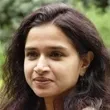Lens on Reality: Media, Sensuous Ethnography, and New Dance in India

Pallabi Chakravorty is associate professor in the Department of Music and Dance and a scholar of visual anthropology, performance, and culture. Trained in Kathak dance by respected gurus in Kolkata, Chakravorty upholds the integration of theory and practice both in her research, teaching, and artistic works. She is the author/editor of four books and proceedings and several journal articles and book chapters, most notably "Bells of Change: Kathak Dance, Women, and Modernity in India." Her current research focuses on Indian dance and media, especially dance reality shows, Bombay film dance, and the Bollywoodization of Indian culture. Pallabi is the founder and artistic director of Courtyard Dancers, a nonprofit based in Philadelphia.
This presentation is based on Chakravorty's ethnographic research in India among choreographers and reality show dancers for the past several years to explore new forms of subjectivities that are being forged through the interactions of various media technologies such as: cinema, video, YouTube, and television. She investigates how these new technologies interact with traditional visual cultures like dance and ritual. In reference to the two broad yet related themes that she explores within this lecture, Chakravorty says:
"First, I look at the broadening of the dance context in urban India due to liberalization of the economy and spread of new media and technology," she says. "The rise of Bollywood dance and Bollywood films - they used to be called filmi dance and Bombay films - is an engine for the new visibility of dance in India and in the global pop-culture. In fact, one could argue that Bollywood dance and Bollywood films are among the most visible products of India's new economy. While dance reality shows in India may be conceptually borrowed from reality shows in the west, I argue that they are deeply grounded in the visual and sensory culture of India and its all-pervasive media apparatus: Bollywood films. My investigation here is concerned with uncovering this indigenous logic by tracing the genealogy of the dance reality show genre from the song and dance sequences of Bombay/Bollywood films and its by product, music videos. This part of the research is enriched by archival work I conducted at the National Film Archives in Pune.
"Second, I analyze how the broadening of the dance context due to the rise of new media has allowed women and men from under-privileged classes to acquire a new kind of media citizenry by participating in dance reality shows," she adds. "The explosion of television dance reality shows in India has enabled the formation of a rich tapestry of lives, desires, aspirations, and experiences. In order to uncover these subjectivities within a mediatized global Indian modernity, I explore the conceptual framework of "desire" to express the aspirations and dreams of the reality show dancers. I show how "desire" takes new aesthetic-emotional forms and is expressed through new embodiments of masculinity and femininity. I locate these transformations by following some key dancers and choreographers in Kolkata and Mumbai, in movie studios, dance classes and dance halls, during auditions, in their homes, shopping malls, and on television."



